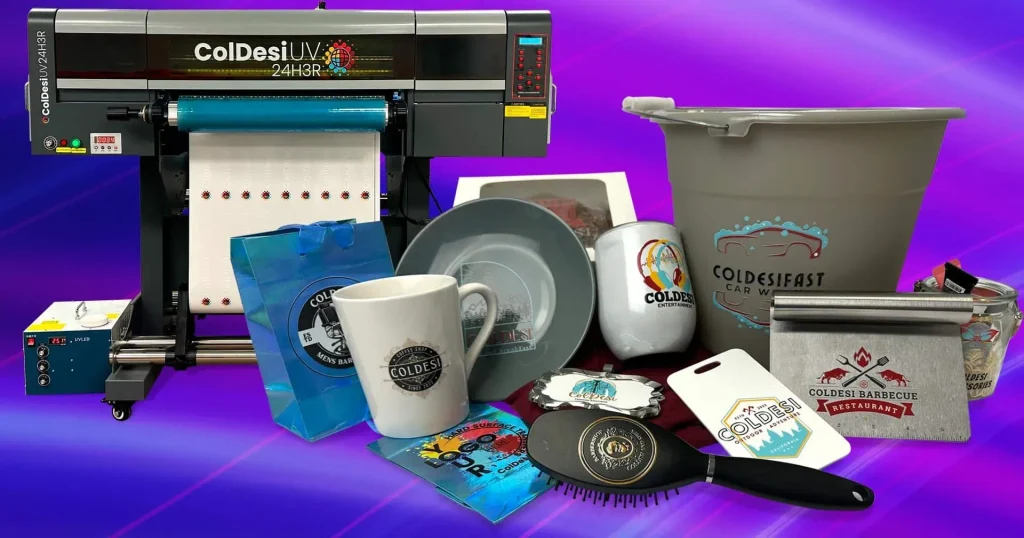UV DTF printing is revolutionizing the way businesses approach their printing needs, offering cutting-edge solutions that leverage the latest UV printing technology. This innovative method of Direct to Film printing utilizes ultraviolet light to cure inks, resulting in stunningly vibrant and durable prints suitable for a wide array of materials. With the advantages of UV printing becoming increasingly evident, companies can enjoy enhanced durability of UV prints, reducing the wear and tear that traditional inks might suffer from. While UV printing costs can vary, the long-term benefits often outweigh initial investments for businesses seeking quality and longevity in their printed products. In this article, we’ll explore the ins and outs of UV DTF printing, providing insights into its strengths and challenges to help you determine if it’s the right fit for your printing operations.
The realm of printing is experiencing an exciting transformation with the advent of technologies like DTF (Direct to Film) printing combined with UV curing techniques. Often referred to as UV printing, this sophisticated method allows for direct applications on a multitude of materials, enhancing the versatility and quality of print products. As more businesses become aware of the substantial benefits linked to this technique, particularly in terms of vibrant color reproduction and print durability, the landscape of printing is shifting. This exploration of UV DTF printing will delve into its operational dynamics, cost considerations, and the overall impact on print quality and application versatility for various industries. Join us as we dissect how these advancements can redefine your printing projects.
Understanding UV DTF Printing Technology
UV DTF printing technology, or Direct to Film printing, has emerged as a revolutionary process in the printing industry. Unlike traditional methods, this technology uses ultraviolet light to cure inks immediately as they are printed onto a special film. This allows for exceptional color vibrancy and detail in prints, making it particularly attractive for businesses focused on high-quality outputs. Furthermore, the ability to print directly onto a variety of substrates such as textiles, plastics, and metals sets UV DTF apart from other printing techniques, offering businesses a seamless solution for diverse applications.
One of the key elements that make UV DTF printing an appealing option is the efficiency it brings to the production process. With rapid curing using UV light, businesses can print and transfer designs quickly without lengthy drying times, which is often the case with solvent-based inks. This feature not only boosts productivity but also reduces the overall ink consumption, resulting in lower environmental impact. Additionally, the precision of Direct to Film printing maximizes material use and minimizes waste, aligning well with eco-friendly business practices.
Advantages of UV DTF Printing
The advantages of UV DTF printing are manifold, making it an increasingly popular choice for numerous industries. For starters, the durability of UV prints is one of the most compelling selling points. The UV curing process improves ink adhesion significantly, resulting in prints that are resistant to scratches, fading, and peeling. This exceptional durability is essential for items intended for outdoor use or those subjected to regular wear and tear, such as promotional products and apparel.
In addition to durability, the vibrancy and detail achievable through UV DTF printing cannot be overstated. The technology allows for high-resolution prints with vivid colors, catering perfectly to businesses in fashion, art, and product packaging. This capability to reproduce intricate designs makes it especially suitable for artists and marketers who demand the highest quality visuals. By choosing UV printing technology, companies can elevate their branding while offering products that stand out in competitiveness and appeal.
Comparing UV DTF Printing Costs with Other Methods
When it comes to analyzing UV DTF printing costs compared to traditional methods, there are several factors to consider. While the initial investment for UV DTF printers and inks may be higher, the long-term benefits can offset these upfront costs. Businesses that adopt this technology often realize savings through reduced waste, lower ink consumption, and faster turnaround times. Additionally, the level of print durability achieved can lead to increased customer satisfaction and repeat business, further enhancing return on investment.
Moreover, it is essential to weigh the total cost of ownership against the benefits of high-quality outputs. Traditional methods like screen printing or dye sublimation may seem more budget-friendly initially, but they may involve ongoing costs related to material replacement and prolonged production times. On the other hand, the durability of UV DTF prints means less frequent reprinting or touch-ups, ultimately leading to cost efficiency in the long run.
The Environmental Benefits of UV DTF Printing
One of the noteworthy benefits of UV DTF printing is its environmental advantage over many traditional printing processes. UV inks are known to contain fewer volatile organic compounds (VOCs) compared to solvent-based inks, making them a more eco-friendly option. This reduction in harmful emissions during the printing process not only supports compliance with environmental regulations but also caters to the growing consumer preference for sustainable products.
Furthermore, the instantaneous curing process associated with UV printing technology minimizes both energy consumption and production waste. Industries increasingly prioritize sustainable practices, and adopting UV DTF printing can enhance a company’s reputation while contributing positively to the planet. By reducing their ecological footprint, businesses can appeal to environmentally conscious consumers and bolster their market position.
Challenges Faced by UV DTF Printing
While UV DTF printing presents multiple advantages, it is worth noting the challenges that come with it. One significant hurdle is the steep learning curve associated with its setup and maintenance. Unlike traditional printing methods, mastering the intricacies of direct to film technology requires specialized knowledge of various substrates and ink settings. Companies aiming to implement UV DTF printing must invest in training personnel to ensure optimal results, which can be a barrier for some businesses, especially start-ups.
Additionally, the initial financial outlay for UV DTF printers and materials can be daunting. Although the long-term savings may justify this investment, smaller operations may struggle to find the necessary capital upfront. Therefore, potential adopters of UV printing technology must carefully assess their financial capabilities and project the long-term benefits against initial costs to make an informed decision.
The Future of UV DTF Printing in the Industry
The future of UV DTF printing looks promising as more industries embrace technological advancements in the printing sector. As consumer demands for high-quality and durable prints continue to rise, businesses are seeking innovative solutions to maintain a competitive edge. UV printing technology, with its combination of versatility and unmatched print quality, positions itself as a frontrunner in meeting these evolving market expectations.
Furthermore, ongoing advancements in UV DTF printing technology are likely to enhance usability, expand color options, and reduce costs, making this method even more accessible to a wider range of businesses. As manufacturers continue to innovate and reduce the complexities involved, UV DTF printing will become an indispensable tool for companies looking to strike a balance between quality, cost efficiency, and environmental responsibility.
Frequently Asked Questions
What are the main advantages of UV DTF printing over traditional methods?
UV DTF printing offers several advantages over traditional methods, including versatility to print on various substrates, excellent durability due to the UV curing process, and the ability to produce vibrant colors and intricate designs. Additionally, UV printing technology is more eco-friendly, as it emits fewer volatile organic compounds (VOCs) during the printing process.
How does the UV printing technology ensure the durability of UV prints?
The durability of UV prints is enhanced through the use of UV curing, which allows inks to adhere better to the printed surface. This results in prints that are resistant to scratching, fading, and peeling, making UV DTF printing ideal for items that undergo frequent handling or are exposed to outdoor conditions.
What cost should I expect when investing in UV DTF printing equipment?
UV printing costs can be significant, particularly for the initial setup which includes purchasing a UV DTF printer and the necessary inks. These upfront costs may be a consideration for small businesses or startups. However, the investment can pay off with the high-quality and durable prints produced.
Can UV DTF printing achieve high-resolution and detailed designs?
Yes, UV DTF printing excels in creating high-resolution images with vivid colors. The technology is particularly suited for intricate designs, making it a preferred choice for businesses needing detailed artwork, such as photo printing and customized promotional items.
What types of materials can be used with UV DTF printing?
UV DTF printing is incredibly versatile as it can be used on a wide range of materials, including textiles, plastics, metals, and even wood. This adaptability makes it suitable for multiple industries, from fashion to product packaging.
How does the environmental impact of UV DTF printing compare to other printing technologies?
Compared to traditional printing technologies, UV DTF printing is more environmentally friendly due to its lower emissions of volatile organic compounds (VOCs) and the immediate curing of inks, which eliminates lengthy drying times. This makes UV printing technology a greener option for businesses looking to reduce their ecological footprint.
| Aspect | Details |
|---|---|
| What is UV DTF Printing? | A printing technology that allows for direct transfer of prints onto various materials using UV light curing. |
| Pros | 1. Versatility across multiple substrates. 2. Durability against elements and wear. 3. High-resolution images with vibrant colors. 4. Environmentally friendly with lower VOCs. |
| Cons | 1. High initial equipment costs. 2. Complexity in setup and maintenance. 3. Limited color options compared to other methods. |
Summary
UV DTF Printing is an advanced technology that offers innovative solutions for businesses seeking high-quality prints. With its remarkable versatility to print on various substrates and the capability to produce durable, vivid images, UV DTF Printing stands out in the printing market. However, potential users must carefully consider the initial costs and the complexity of the equipment. The benefits of UV DTF Printing may outweigh the challenges, making it an attractive option for those focused on exceptional print quality and environmental sustainability.



